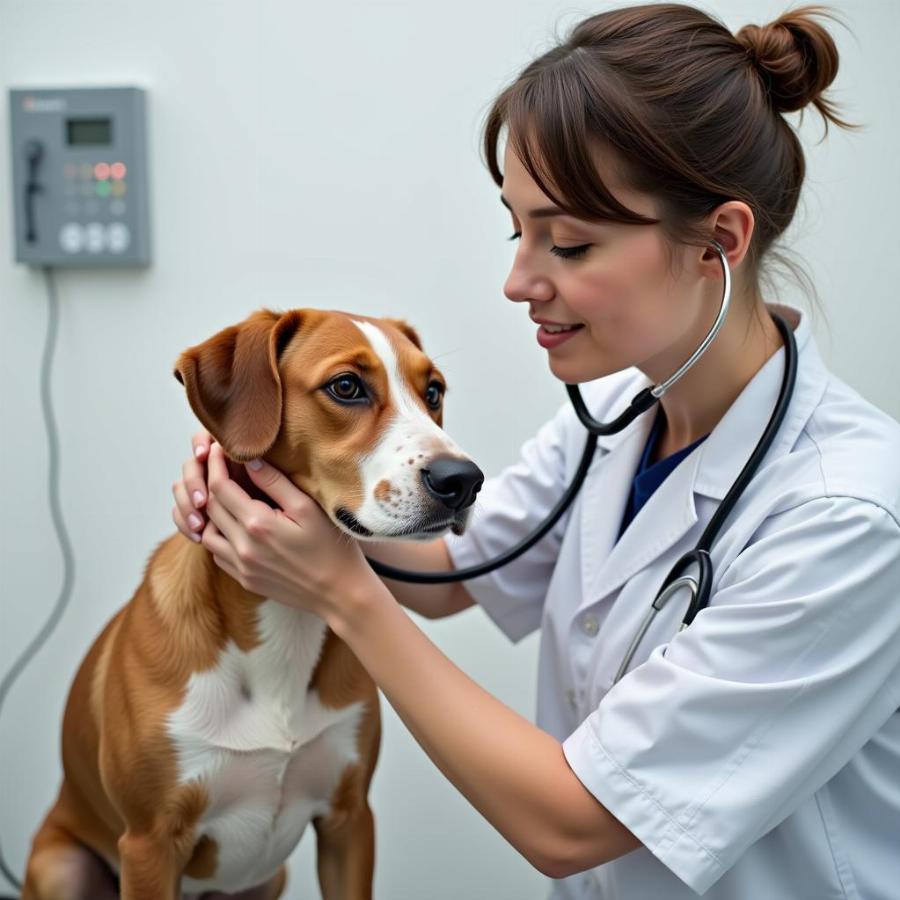Cephalexin is a commonly prescribed antibiotic for dogs, used to treat a variety of bacterial infections. Understanding the correct cephalexin dog dose is crucial for effective treatment and your dog’s safety. This guide provides comprehensive information on cephalexin dosage for dogs, potential side effects, and important considerations to ensure responsible administration.
Understanding Cephalexin for Dogs
Cephalexin, a broad-spectrum antibiotic belonging to the cephalosporin class, effectively combats bacterial infections in dogs. It works by inhibiting the growth of bacterial cell walls, ultimately leading to their destruction. Vets often prescribe cephalexin for skin infections, urinary tract infections, respiratory infections, and bone infections in dogs. It’s important to remember that cephalexin only treats bacterial infections and is ineffective against viral or fungal infections.
Determining the Correct Cephalexin Dog Dose
The appropriate cephalexin dog dose depends on several factors, including the dog’s weight, the severity of the infection, and the vet’s professional judgment. While a general guideline is 10-15 mg per pound of body weight, administered every 8-12 hours, this is not a substitute for veterinary advice. Always consult your veterinarian to determine the correct dosage for your dog. They will consider your dog’s specific needs and medical history to ensure safe and effective treatment. Never attempt to self-medicate your dog with cephalexin or any other medication. dog antibiotics cephalexin dosage
What is the typical cephalexin dosage for a dog?
A typical cephalexin dosage is 10-15mg/lb, every 8-12 hours, but only a vet can determine the precise dose for your dog’s specific situation.
How do I calculate the correct cephalexin dose for my dog?
Do not attempt to calculate the dosage yourself. Always consult with your vet, who will consider your dog’s weight, health, and the infection being treated to determine the right dose.
Administering Cephalexin to Your Dog
Cephalexin is available in both capsule and liquid form. If your dog struggles with swallowing pills, the liquid form can be easier to administer, often mixed with a small amount of food. However, some dogs may dislike the taste of cephalexin, regardless of the form. Your vet may offer advice on how to make administration easier. Complete the full course of antibiotics prescribed by your vet, even if your dog’s symptoms improve before the medication is finished. Stopping the medication early can lead to antibiotic resistance. erythromycin for dogs
Potential Side Effects of Cephalexin in Dogs
While generally safe, cephalexin can cause side effects in some dogs. These can include vomiting, diarrhea, loss of appetite, and lethargy. If you observe any of these side effects, consult your veterinarian. In rare cases, more serious allergic reactions can occur, such as facial swelling, hives, or difficulty breathing. Seek immediate veterinary attention if your dog exhibits any signs of an allergic reaction.
What should I do if my dog experiences side effects from cephalexin?
Contact your veterinarian immediately if you notice any side effects, especially vomiting, diarrhea, loss of appetite, or allergic reactions.
Are there any serious side effects I should be aware of?
While rare, serious allergic reactions like facial swelling, hives, or difficulty breathing can occur. Seek immediate veterinary attention if your dog displays these symptoms.
Important Considerations Regarding Cephalexin Use in Dogs
- Pregnant or Nursing Dogs: Consult your veterinarian before administering cephalexin to pregnant or nursing dogs.
- Allergies: Inform your vet if your dog has any known allergies to medications, particularly penicillin or other antibiotics. cephalexin for dogs without vet prescription
- Other Medications: Disclose all other medications your dog is currently taking to avoid potential drug interactions.
- Storage: Store cephalexin in a cool, dry place away from direct sunlight and out of reach of children and pets.
 Veterinarian examining a dog
Veterinarian examining a dog
Conclusion
Understanding the proper cephalexin dog dose is crucial for its effectiveness and your dog’s well-being. While this guide provides valuable information, it is essential to consult your veterinarian for personalized guidance on dosage, administration, and potential side effects. Responsible medication administration, coupled with professional veterinary care, will ensure your furry companion receives the best possible treatment. convenia for dogs
FAQ
- Can I give my dog human cephalexin? No, never administer human medication to your dog without consulting your vet.
- What if I miss a dose? Give the missed dose as soon as you remember, but don’t double up if it’s close to the next scheduled dose.
- How long does cephalexin take to work? You may see improvement within a few days, but complete the entire course as prescribed.
- Can cephalexin be given with food? Yes, it can be given with or without food.
- What if my dog vomits after taking cephalexin? Contact your veterinarian for advice.
- Can cephalexin cause yeast infections in dogs? In some cases, yes. Monitor your dog for any signs of a yeast infection, such as itching or redness.
- Is cephalexin safe for all dog breeds? While generally safe, certain breeds may have sensitivities. Discuss this with your veterinarian.
Beaut Dogs is your trusted resource for all things related to dog care, providing expert advice and reliable information on a variety of topics. When you need support, please contact us via Email at [email protected] for detailed and accurate answers from Beaut Dogs. We’re dedicated to helping you navigate the wonderful world of dog ownership and provide the best possible care for your canine companion. Visit us at https://beautdogs.com.